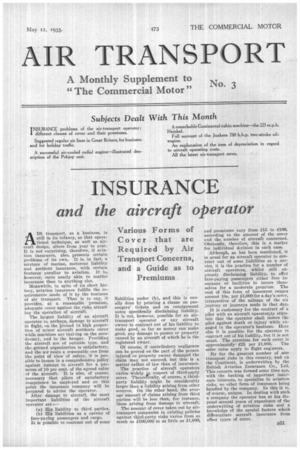INSURANCE
Page 49

If you've noticed an error in this article please click here to report it so we can fix it.
and the aircraft operator
Various Cover Forms of that are Required by Air Transport Concerns, and a Guide as to Premiums
AIR transport, as a business, is still in its infancy, so that operational technique, as well as aircraft design, alters from year to year. It is not surprising, therefore, if aviation insurance, also, presents certain, problems, of its own. It is, in fact, a mixture of marine, motorcar liability and accident insurance, with certain features peculiar to aviation. It is, however, more nearly akin to marine insurance than to anything else.
Meanwhile, in spite of its short history, aviation insurance fulfills the requirements made of it by the business of air transport. That is to say, it provides, at a reasonable premium, adequate cover against the risks attending the operation of aircraft.
The largest liability of an aircraft operator is, perhaps, damage to aircraft in flight, on the 'g,round (a high proportion of minor aircraft accidents occur while machines are taxi-jag on the aerodrome), and in the hangar. Providing the aircraft are of suitable type, and the ground organization is satisfactory, and the air route a reasonable one from the point of view of safety, it is possible to insure in a comprehensive policy against damage to aircraft for a premium of 19 per cent, of the agreed value of the aircraft. It is also, of course, necessary that pilots of satisfactory competence be employed and on this point the insurance company will be prepared to advise the operator.
After damage to aircraft, the most important liabilities of the aircraft Operator are :— (a) His liability to third parties.
(b) His liabilities as a carrier of fare-paying passengers and cargo. It is possible to contract out of some liabilities under (b), and this is usually done by printing a clause on passengers' tickets and on consignment notes specifically disclaiming liability. It is not, however, possible for an airtransport operator or any aircraft owner to contract out of his liability to make good, so far as money can make good, any damage to person or property caused by an aircraft of which he is the registered owner.
Of course, if contributory negligence can be proved on the part of the person injured or property owner damaged the claim may not succeed, but this is a matter rather of law than of insurance.
The practice of aircraft operators varies widely in respect of third-party cover. Theoretically, of course, a thirdparty liability might be considerably larger than a liability arising from other sources. On the other hand, the average amount of claims arising from third parties will be.less than, for instance, those arising from 'damage to aircraft.
The amount of cover taken out by airtransport companies in existing policies against third-party risks varies from as much as £100,000 to as little as £1,000, and premiums vary from £15 to £100, according to the amount of the cover and the number of aircraft concerned. Obviously, therefore, this is a matter for individual decision in each case.
Although, as has been mentioned, it is usual for an aircraft operator to contract out of some liabilities as a carrier, it is the practice for a number of aircraft operators, whilst still expressly disclaiming liability, to offer fare-paying passengers either free insurance or facilities to insure themselves for a moderate premium. The cost of this form of insurance ranges around 10s. per £1,000 for a day's cover, irrespective of the mileage of the air journey or journeys made in that day.
It is customary for the contract of a pilot with an aircraft operator.tp stipulate that the operator shall insure the pilot against death or injury while engaged in the operator's business. Here also it is possible for the operator to contract out of his liability, but it is not usual. The premium for such cover is
approximately £25 per £1,000. The same rates apply to Hight engineers.
By far the greatest number of airtransport risks in this country, and on the Continent, is underwritten by the British Aviation Insurance Co., Ltd. This concern was formed some time ago, with the backing of important insurance interests, to specialize in aviation risks, no other form of insurance being handled by the company. In this it is, of course, unique. In dealing with such a company the operator has at his disposal several years of experience of the underwriting of aviation risks and a knowledge of the special factors which differentiate aircraft insurance from other types of cover.




































































































